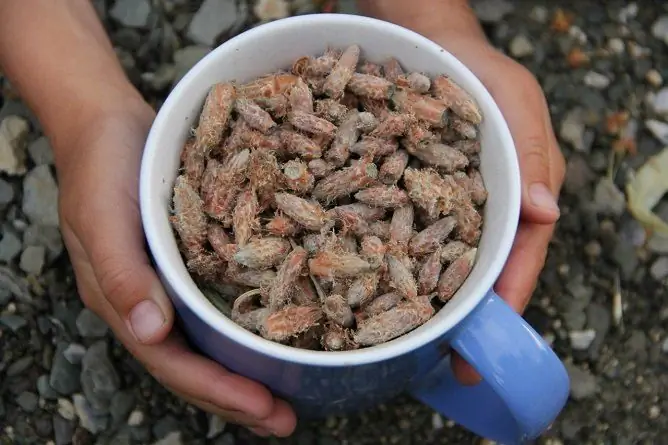- Author Rachel Wainwright [email protected].
- Public 2023-12-15 07:39.
- Last modified 2025-11-02 20:14.
Scots pine
Instructions for use:
- 1. Description
- 2. Application
- 3. Contraindications
Prices in online pharmacies:
from 69 rub.
Buy
Scots pine description

Scotch pine, also known in Russia as forest pine, is an evergreen coniferous tree with a straight trunk, long paired needles and a round or conical crown, reaching a height of 40 meters. Scots pine cones have an elongated ovoid shape, and the winged gray seeds of the tree usually ripen in the second or third year. Also in the description of Scots pine it is said that the buds and needles of the tree contain many useful substances - up to 0.5% of essential oils, tannins and bitter substances, vitamin C and resins.
Pine buds are harvested in the spring before they bloom. They contain large amounts of essential oils and resins, as well as bitter and tannins, starch and mineral salts. The collected buds are dried at a temperature not higher than 20-25 ° C, best of all under a canopy or in the attic.
Scots pine needles are rich in vitamin C and carotene. It is used to obtain an essential oil that is widely used to treat rheumatic diseases. It is recommended to collect Scots pine needles in winter or late autumn, when it contains the greatest amount of essential oil and ascorbic acid.
Scots pine resin or sap is usually collected from trees to be cut. Harvested raw materials should not be stored for more than 2 years.
Scots pine application
Scotch pine as a medicinal plant has long been used for compresses and poultices, and the resin of the tree, which is part of the embalming compositions of Ancient Egypt, retains its bactericidal properties for thousands of years. Also, the healing properties of Scots pine in many countries were used to treat colds and to disinfect the oral cavity.
For medicinal purposes, pine needles, resin, buds and tree cones are used, which have an expectorant, vitamin, irritant, choleretic, diuretic, antimicrobial and anti-inflammatory effect. In folk medicine, they are used for pulmonary tuberculosis and respiratory diseases, dropsy, neuralgia, rheumatism, gout, rickets, scurvy, skin diseases, as well as against parasitic insects and as a blood purifier. In addition, tar, turpentine, wood vinegar and rosin are obtained from Scotch pine.
Scots pine cones are used in the form of infusion and tinctures for pain in the heart and as a hemostatic agent. To prepare an infusion for the treatment of heart pains, green pine cones collected in spring are poured into a jar, poured with vodka and insisted in a dark place for a week. The resulting infusion is best taken before meals, three times a day, one tablespoon.
Scots pine buds are used in the form of aqueous infusions and decoctions for bronchitis, dropsy, rheumatism, liver and gastrointestinal tract diseases as an expectorant, disinfectant, antiseptic, anti-inflammatory, diuretic and choleretic agent.
To prepare a decoction of pine buds, one tablespoon of raw materials is poured with a glass of hot boiled water and heated in a boiling water bath for half an hour. It is taken several times a day after meals for a quarter of a glass. The cooked decoction of Scots pine buds can be stored for no more than 2 days.

Water infusions and decoctions from tree needles are used in the prevention and treatment of vitamin C deficiency. They can also be used for therapeutic baths and treatment of burns and wounds. To prepare the infusion, the pine needles must first be ground with a small amount of cold boiled water, then add a 3- or 9-fold proportion of water and boil for 20-40 minutes. You can add citric acid to it to taste. Take the infusion after a few hours, 1 / 4-1 / 2 glass per day.
To prepare an infusion for baths from needles or pine buds, 0.5-1 kg of raw materials are poured into 3 liters of boiling water and infused for 3 hours. For the treatment of abscesses, you can use a decoction of needles, twigs and cones of Scots pine, which are pre-boiled for half an hour and insisted for 12 hours.
Scots pine turpentine is used to treat sciatica, lumboischialgia, neuralgia, arthritis, myositis, rheumatism and gout as a local irritant and anesthetic. Tar is used externally as an antiparasitic and disinfectant for scaly lichen, eczema and scabies, and resin is used for the treatment of ulcers and long non-healing wounds.
Contraindications
Decoctions and infusions of Scots pine should be taken with caution in case of hypersensitivity, as well as in severe kidney disease. Baths made of pine needles are contraindicated in cases of severe hypertension, cardiovascular diseases with impaired blood circulation, infectious skin diseases, malignant neoplasms, as well as the presence of acute inflammatory processes. With external use of turpentine, it should be borne in mind that it can cause hyperemia of the skin, and in large quantities leads to excitation of the central nervous system, manifested as insomnia, shortness of breath, anxiety and increased blood pressure.
Scots pine: prices in online pharmacies
|
Drug name Price Pharmacy |
|
Essential oil Scots pine essential oil 10 ml 1 pc. RUB 69 Buy |
|
Essential oil Blumenberg (Blumenberg) Scots pine 10 ml 79 RUB Buy |
|
Essential oil Aspera Scots pine 10 ml RUB 99 Buy |
Information about the drug is generalized, provided for informational purposes only and does not replace the official instructions. Self-medication is hazardous to health!






